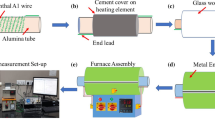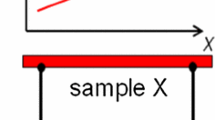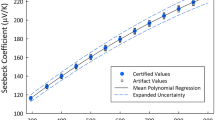Abstract
The transport properties of ceramic materials strongly depend on oxygen activity, which is tuned by changing the partial oxygen pressure (pO2) prior to and during measurement. Within, we describe an instrument for highly stable measurements of Seebeck coefficient and electrical resistivity at temperatures up to 1300 K with controlled oxygen partial pressure. An all platinum construction is used to avoid potential materials instabilities that can cause measurement drift. Two independent heaters are employed to establish a small temperature gradient for Seebeck measurements, while keeping the average temperature constant and avoiding errors associated with pO2-induced drifts in thermocouple readings. Oxygen equilibrium is monitored using both an O2 sensor and the transient behavior of the resistance as a proxy. A pO2 range of 10−25–100 atm can be established with appropriate gas mixtures. Seebeck measurements were calibrated against a high purity platinum wire, Pt/Pt–Rh thermocouple wire, and a Bi2Te3 Seebeck coefficient Standard Reference Material. To demonstrate the utility of this instrument for oxide materials we present measurements as a function of pO2 on a 1 % Nb-doped SrTiO3 single crystal, and show systematic changes in properties consistent with oxygen vacancy defect chemistry. An approximately 11 % increase in power factor over a pO2 range of 10−19–10−8 atm at 973 K for the donor-doped single crystals is observed.






Similar content being viewed by others
References
Lee S, Bock JA, Trolier-McKinstry S, Randall CA (2012) Ferroelectric-thermoelectricity and Mott transition of ferroelectric oxides with high electronic conductivity. J Eur Ceram Soc 32:3971–3988
Koumoto K, Funahashi R, Guilmeau E, Miyazaki Y, Weidenkaff A, Wang YF, Wan CL (2013) Thermoelectric ceramics for energy harvesting. J Am Ceram Soc 96:1–23
Moos R, Hardtl KH (1997) Defect chemistry of donor-doped and undoped strontium titanate ceramics between 1000 degrees and 1400 degrees C. J Am Ceram Soc 80:2549–2562
Baumard JF, Tani E (1977) Thermoelectric power in reduced pure and Nb-doped TiO2 rutile at high temperature. Phys Status Solidi A 39:373–382
Nowotny J, Bak T, Burg T (2007) Electrical properties of polycrystalline TiO2. Thermoelectric power. Ionics 13:155–162
Maier J (1993) Defect chemistry: composition, transport, and reactions in the solid-state; Part I: thermodynamics. Angew Chem-Int Ed Engl 32:313–335
Smyth DM (2000) The defect chemistry of metal oxides. Oxford University Press, New York
Kröger FA, Vink HJ (1956) Relations between the concentrations of imperfections in crystalline solids. Solid State Phys 3:307–435
Lupetin P (2012) Charge carrier defect chemistry of nanoscopic SrTiO3. Max-Planck-Institut für Festkörperforschung, Universität Stuttgart, Stuttgart
Moos R, Gnudi A, Hardtl KH (1995) Thermopower of Sr1−xLaxTiO3 ceramics. J Appl Phys 78:5042–5047
Dorris SE, Mason TO (1988) Electrical properties and cation vacancies in Mn3O4. J Am Ceram Soc 71:379–385
Jung JI, Misture ST, Edwards DD (2010) Oxygen stoichiometry, electrical conductivity, and thermopower measurements of BSCF (Ba0.5Sr0.5Co x Fe1−x O3−d, 0 <= x <= 0.8) in air. Solid State Ion 181:1287–1293
Byl C, Berardan D, Dragoe N (2012) Experimental setup for measurements of transport properties at high temperature and under controlled atmosphere. Meas Sci Technol 23:035603
Martin J, Tritt T, Uher C (2010) High temperature Seebeck coefficient metrology. J Appl Phys 108:121101–121112
Roberts RB, Righini F, Compton RC (1985) Absolute scale of thermoelectricity III. Philos Mag Part B 52:1147–1163
E230 A Standard Specification and Temperature-Electromotive Force (emf) Tables for Standardized Thermocouples, vol ASTM E230. ASTM International
Meyer R, Waser R, Helmbold J, Borchardt G (2002) Cationic surface segregation in donor-doped SrTiO3 under oxidizing conditions. J Electroceram 9:103–112
Acknowledgements
The authors would like to acknowledge Kathy Wilkerson for aiding in the preparation of schematics of the measurement system and R.H.T. Wilke for his critical review of this manuscript. This work was funded by the Laboratory Directed Research and Development program at Sandia National Laboratories. Sandia National Laboratories is a multi-program laboratory managed and operated by Sandia Corporation, a wholly owned subsidiary of Lockheed Martin Corporation, for the U.S. Department of Energy’s National Nuclear Security Administration under contract DE-AC04-94AL85000.
Author information
Authors and Affiliations
Corresponding author
Electronic supplementary material
Below is the link to the electronic supplementary material.
Rights and permissions
About this article
Cite this article
Brown-Shaklee, H.J., Sharma, P.A. & Ihlefeld, J.F. Instrument for stable high temperature Seebeck coefficient and resistivity measurements under controlled oxygen partial pressure. J Mater Sci 50, 5005–5013 (2015). https://doi.org/10.1007/s10853-015-9049-2
Received:
Accepted:
Published:
Issue Date:
DOI: https://doi.org/10.1007/s10853-015-9049-2




